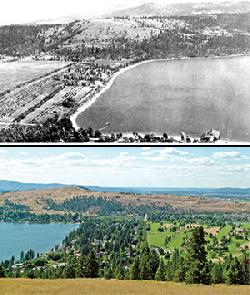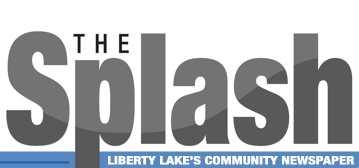 |
| Photos courtesy of Liberty Lake Historical Society |
The northern shore of Liberty Lake, shown as the camera pans east in the top black and white photo, was mostly undeveloped in 1937, three years prior to the purchase of the property by Homer Neyland. A lot changed — and grew — in 70 years, as this same area captured in the west-facing 2007 photo on the bottom reveals.
|
|
|
|
|
History: The advent of golf and LL's Country Club Addition
5/28/2015 8:55:49 AM
By Ross Schneidmiller
Liberty Lake Historical Society
In 1940, Homer Neyland purchased and began development on a 170-acre tract of land at Liberty Lake. It included 1½ miles of lake frontage on the northern and eastern sides. The western boundary of the plat was Molter Avenue. It encompassed the entire north end of the lake, extending up the eastern shoreline to the northern tip of MacKenzie Bay. A major benefit to the community was the building of a road that connected Molter to the south end of the lake via Sprague and Neyland avenues. Seven beach lots of varying sizes sold quickly. Eager to enjoy lake life, the purchasers planned to begin building in the spring of 1941.
By spring of 1945, the Spokane Valley Country Club purchased 50 acres of this land. The newly formed organization was made up of businessmen from Spokane Valley and Liberty Lake. It was their intention to build a clubhouse and nine-hole golf course for its members along with other lakeside and recreational facilities. That prior winter, Frank James, a well-respected golf course architect, laid out the fairways. With every green overlooking the lake, the Spokane paper proclaimed it would be one of the most beautiful in the country. The clubhouse was completed in June 1945 and the putting green the following month.
The Club, which planned to limit its membership to 200, struggled in building the golf course. Initially they announced that the course would be ready to play later that year. The opening date was moved back to the following spring, but that did not happen either. Plans changed by the early 1950s, and the club purchased an additional 109 acres north of Sprague Avenue to build 18 holes of golf. The original acreage was subdivided into 110 residential lots, the sale of which would help generate funds to build the course.
Known as the Valley Country Club Addition, the plat included both lake frontage and secondary parcels. Most of the houses were expected to be rambling ranch style dwellings, with an average cost of $16,000.
"We believe the completion of the Spokane Valley freeway will act as a spur to the development of Liberty Lake," stated Samuel Ward, an officer of the Club who announced the real estate development, "Residents of the area will be able to get to downtown Spokane in about 20 minutes."
They were correct in their assessment; however, the freeway was not completed to Liberty Lake until 1964, nearly 10 years after Samuel Ward made his prediction. Lot sales did not happen fast enough to generate the funds needed to build the course. It had now been 12 years since the Country Club had tried to provide golf for its membership through its various plans. Realizing an organization as small as theirs could not build and operate a golf course at Liberty Lake, they abandoned the idea of a private golf club. In 1957, they offered to donate 109 acres to Spokane County to be used as a golf course for the public. Participating in purchasing another 22.5 acres with the county sealed the deal.
The following year, as the county was working on the 132-acre, 18-hole course, the Country Club made a proposal to the Spokane Elks Lodge. The Club would transfer its assets valued at $171,227, including the clubhouse facility and 40 unsold residential lots, if the Elks would assume the Club's debt of $21,351. The membership of the Lodge voted in favor of the proposal. It was announced that facilities at the clubhouse would be expanded and remodeled to provide a family recreation facility for Elks membership, which totaled in the thousands. Many of the Spokane Valley Country Club members joined the Elks.
A year later in 1959, the newly remodeled clubhouse was bustling with a full schedule of summer activities. The women's weekly bridge luncheons were well attended. A three-day celebration was in the works to dedicate the recently completed terrace gardens. And, the golf committee had planned several tournaments throughout the summer and fall at the newly completed Liberty Lake Golf Course.
This author's parents purchased a lot and built a home in the Valley Country Club Addition in 1956, just a skipping rock distance from the lake and a pitching wedge distance from the golf course. It was a special neighborhood in which to grow up with special neighbors. That, however, is a story for another month.
Ross Schneidmiller is president of the Liberty Lake Historical Society.
• • •
Did you know?
• "Ranch" (also American ranch, California ranch, rambler or rancher) is an architectural style originating in the United States. The ranch house is noted for its long, close-to-the-ground profile and minimal use of exterior and interior decoration. The ranch style was extremely popular with the booming post World War II middle class of the 1940s to 1970s.
• The first two north-south roads intersecting Sprague Avenue east of Molter are Ward and Clubhouse. Ward Road was named for Samuel Ward, mentioned in this article. Clubhouse Road is named for the clubhouse of the Spokane Valley Country Club, which was located adjacent to this street between 1st and 3rd Avenues.
• Harry Goetz was the first president of and the driving force behind the Spokane Valley Country Club. His father was "Dutch Jake" Goetz, who was well known in earlier years at the lake for his picnics that were celebrated with much fanfare and mock.
Advertisement

|
